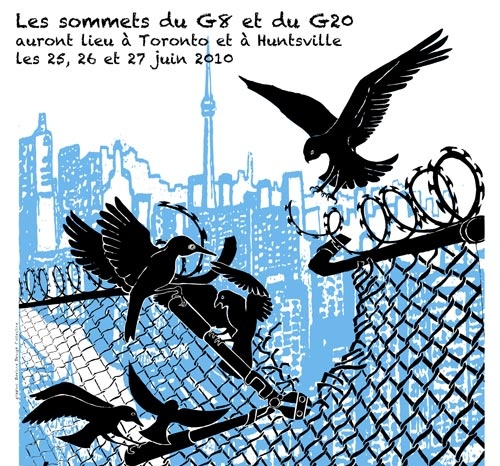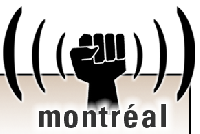 |
 |
 |
 |
 |
 |
|
 |
 |
 |
 |
 |
 |
 |
Régions du Québec |  |
 |
 |
|
 |
 |
|
 |
 |
|
 |
 |
 |
 |
 |
 |
Rubriques (sujets) |  |
 |
 |
|
 |
 |
|
 |
|
 |
 |
 |
Rhythm of tears
Art exhibition from inmates at Concordia
On the next November 25, 2005, from 12:00 pm to 20:00 pm, there will be a free exhibition with the works of Juan Cardenas. The event will take place at the Hall building Mezzanine,at Concordia University.
If you'd like to know more about the artist, please read following article (in english and spanish):
Rhytm of tears.
North American Justice prides itself on its alleged effective penal system and its ability to exercise democracy. Nonetheless, beneath this reality a harsh contradiction depicts the crushing and inhuman conditions that persist in American jails.
Repression and misery perpetuate the increasing number of prisoners. Injustice towards minorities still persists and its policies regarding capital punishment are ranked with those of Iran and China. Prisons do not offer safe conditions for inmates. Violation is a frequent reality that some endure in silence. Also, the appalling living conditions and the negligence and medical incompetence lead to a downfall in the prisoner’s mental and physical health. Health services granted to patients with HIV/AIDS are terribly deficient.
The situation never seems to get better; inmates have suffered these injustices for too long. It should be considered an offense that the United States perceives themselves as the defender of international human rights.
It is in the American state of Texas where Juan Cardenas, an American of Mexican decent, was detained more than ten years ago. The state has denied him guilty of the murder of David de Leon the night of May 9, 1992 during a fight in a party. He now faces a sentence of life imprisonment. The specialists report does not reveal any concrete evidence that confirms Juan's guilt. The night of this unfortunate event, nor Juan’s weapon or any blood marks were found.
Hand washings taken by a crime scene technician on his hands resulted inconclusive. According to the official records, Steven De Leon, brother of the victim, testified that both Juan Cardenas and Alex Morales were shot at the same time. Nevertheless, he also stated that the situation was hazy and he couldn’t see with accuracy, affirming that Juan shot the weapon that reached the victim. On the other hand, declarations of the witnesses: Erika Lopez, Yvette Moncada, Jesus Ramírez and Judith Fragosa, contradict Steven De Leon’s story.
They declared that Alex Morales was the one who shot the gun. Alex also claimed that Juan was the shooter. Angel Nunez, a friend of the victim declared that Juan was never carrying a weapon. Unfortunately, before trial, Alex Morales died on July 18, 1995 while trying to steal a car. Nevertheless, the state of Texas unjustly used the testimony of Alex Morales, already dead, as evidence against Juan, leaving him without the possibility of facing the testimony of his accuser. The negligence of his lawyer, Bruce Anton, has further exacerbated the case. Finally, he was unable to acquire the exoneration of the charges against him as he was incorrectly informed on April 15, 2002 in regards to the deadline to appeal his case.
Meanwhile, Juan hopes to be able to prove his innocence. Juan is a certified counselor for other prisoners. One of the most tragic encounters that he has experienced is helping another inmate, affected by HIV, during his agony.
He occasionally paints and uses art to his advantage in order to make his seclusion bearable. His paintings are timeless, autobiographical, intuitively sensitive. They reflect the reality amid this silent torture. Through his work we can see the suffering that someone endures behind the bars. In addition, these paintings also reflect the alleviation provided by art as a means of coping with the denial of freedom.
Even though his works have received honorable mentions and awards that have appeared in art magazines, he has slim chances of making a name for himself in a society that is only satisfied when it manages to define and classify, truthfully or not, the unknown.
Still, it is perhaps through his art, that Juan will be liberated some day. It is perhaps through universal art that political practices that perpetuate injustice everywhere will cease.
Hispanic Studies Association
web info: JuanCardenas.beliazatil.info
e-mail: beli...@yahoo.ca, hsa....@gmail.com
El ritmo de lágrimas.
La Justicia Norteamericana se enorgullece desde hace tiempo del supuesto ejercicio de su democracia, de su eficaz sistema penal. Sin embargo, son contradictorias las aplastantes e inhumanas condiciones que se originan en las cárceles estadounidenses
La represión y miseria, institucionalizadas desde antaño, continúan aumentando el número de prisioneros. En Estados Unidos las discrepancias en el sistema de justicia penal hacia las minorías aun persisten. Sus políticas en cuanto a la pena de muerte lo ubican junto a Irán y China. Las prisiones no ofrecen condiciones seguras para los reclusos. La violación es una realidad frecuente que algunos soportan en silencio. Además, las terribles condiciones de vida y la negligencia e incompetencia médica provocan el deterioro en presos con enfermedades mentales y físicas. Los servicios de salud que son otorgados a pacientes con VIH/SIDA son terriblemente deficientes.
La situación nunca ha sido espléndida, la población en las prisiones sufre estos excesos desde hace demasiado tiempo. Es una mentada que Estados Unidos se vea a si mismo, y lo vean en varios sitios, como a un defensor de los derechos humanos en todo el mundo, que considere que en verdad practica lo que tanto divulga.
Es en el estado norteamericano de Texas que Juan Cardenas, estadounidense de padres mexicanos, fue detenido hace más de diez años. El crimen que se le imputa es el homicidio de David de Leon la noche del 9 de mayo de 1992 durante una riña en una fiesta. Ahora enfrenta una pena de cadena perpetua.
El informe pericial no aporta ninguna evidencia contundente que sustente la culpabilidad de Juan. Esa noche no se le encontró arma alguna, ni marcas de sangre.
Las pruebas médicas realizadas en sus manos para determinar indicios del crimen quedaron determinadas como inconclusas por el Estado. De acuerdo al expediente oficial, Steven DeLeon, hermano de la víctima, testificó que Juan Cardenas y Alex Morales dispararon al mismo tiempo, sin embargo también reiteró que a causa de la situación le era impreciso ver con exactitud, depues el mismo afirmó que Juan disparó el arma que alcanzó a la víctima. Por otra parte, las declaraciones de los testigos; Erika Lopez, Yvette Moncada, Jesus Ramírez y Judith Fragosa contradicen la versión de Steven DeLeon.
Ellos señalan solo a Alex Morales como el culpable. Quien por su parte también inculpó a Juan. Angel Nunez, amigo de la víctima también declaró que Juan nunca portaba un arma. Lamentablemente antes del juicio Alex Morales murió el 18 de Julio de 1995 al intentar huir cuando robaba un auto. Aun así el estado de Texas injustamente utilizó el testimonio de Alex Morales, ya muerto, como evidencia contra Juan, quitandole así cualquier posibilidad a Juan de encarar el testimonio de Alex. Para hacer más crítico su caso, la negligencia de su abogado, Bruce Anton, al no informarle debidamente el 15 de abril del 2002 sobre la fecha límite para apelar su caso, ha provocado la imposibilidad de buscar la exoneración de los cargos que se le atribuyen.
Mientras espera poder demostar su inocencia, Juan es consejero en la prisión donde se encuentra. Una de sus experiencias más trágicas es la de atenuar la agonía de otro recluso, enfermo de sida.
El arte también ocupa su tiempo. Juan pinta de vez en cuando para ayudarse en esta situación. Es a través de sus cuadros que su reclusión se ha hecho menos infernal. Su arte es intemporal, autobiográfico, intuitivamente sensible, inclasificable. Refleja contundentemente la realidad dentro de ese infierno. Por medio de su obra se puede ver el sufrimiento que atañe a quienes están tras las rejas de una prisión. Pero también se refleja el alivio que produce el arte como ayuda para soportar el despojo de la libertad.
Aunque sus obras han recibido menciones honoríficas y premios en revistas de arte, estas no tienen grandes posibilidades de encontrar espacio en una sociedad que solo esta tranquila si logra definir y clasificar, verazmente o no, lo desconocido.
Es quizás solo por medio de su arte, que Juan será liberado algún día. Es quizás solo por medio del arte universal que serán eliminadas las políticas que perpetúan la injusticia.
| Documents inclus | Taille |
|---|---|
| 22909.jpg | 0 octets |
 |
 |
 |
 |
Dossier G20 |  |
 |
 |
|
 |
 |
|
 |
Nous vous offrons plusieurs reportages indépendants et témoignages...

Liste des activités lors de ce « contre-sommet » à Toronto Vous pouvez aussi visiter ces médias alternatifs anglophones... Centre des médias Alternatifs Toronto 2010.mediacoop.net Media Co-op Toronto http://toronto.mediacoop.ca Toronto Community Mobilization www.attacktheroots.net (en Anglais) |
 |
 |
 |
 |
 |
 |
 |
CMAQ: Vie associative |  |
 |
 |
|
 |
 |
|
 |
 Collectif à Québec: n'existe plus. Impliquez-vous ! |
 |
 |
 |
 |
 |
 |
 |
 |
|
 |
 |
 |
Ceci est un média alternatif de publication ouverte. Le collectif CMAQ, qui gère la validation des contributions sur le Indymedia-Québec, n'endosse aucunement les propos et ne juge pas de la véracité des informations. Ce sont les commentaires des Internautes, comme vous, qui servent à évaluer la qualité de l'information. Nous avons néanmoins une
Politique éditoriale
, qui essentiellement demande que les contributions portent sur une question d'émancipation et ne proviennent pas de médias commerciaux.
This is an alternative media using open publishing. The CMAQ collective, who validates the posts submitted on the Indymedia-Quebec, does not endorse in any way the opinions and statements and does not judge if the information is correct or true. The quality of the information is evaluated by the comments from Internet surfers, like yourself. We nonetheless have an
Editorial Policy
, which essentially requires that posts be related to questions of emancipation and does not come from a commercial media.


